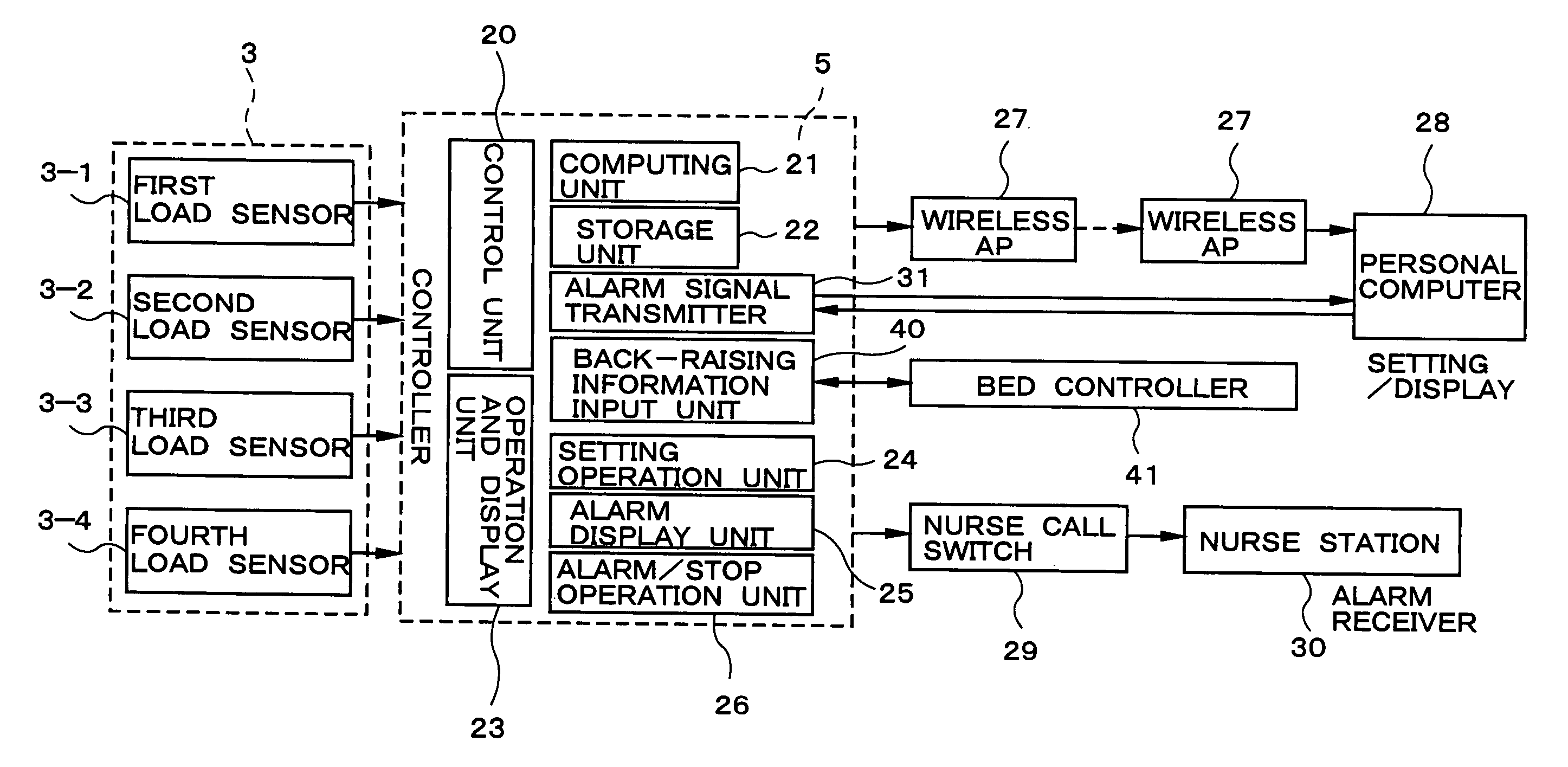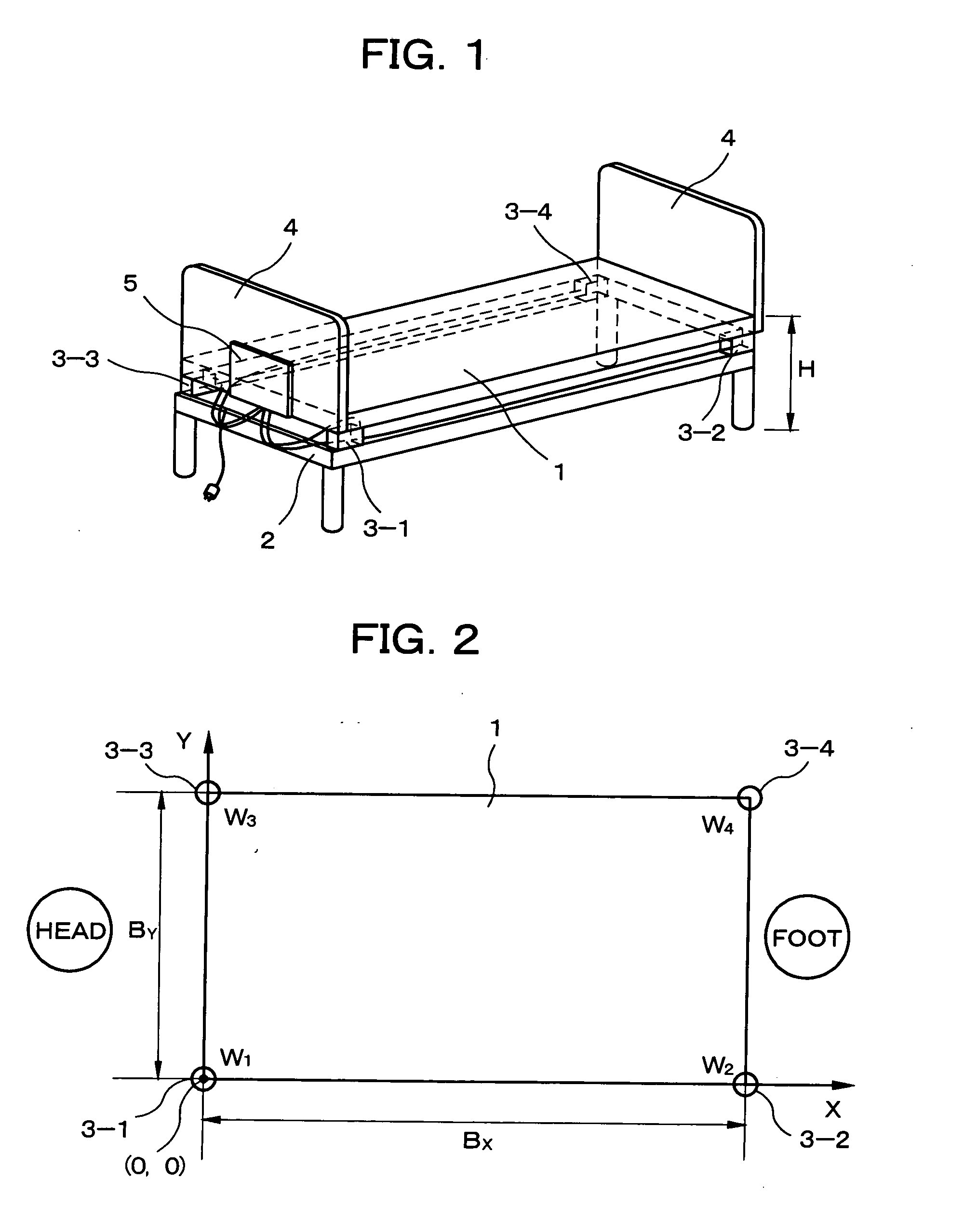Bed apparatus having movable bedboard
a technology of bed apparatus and bed frame, which is applied in the field of bed frame, can solve the problems of high probability, errant detection of dangerous state of user, and high detection accuracy of user, and achieve the effect of improving system reliability and reducing detection accuracy
- Summary
- Abstract
- Description
- Claims
- Application Information
AI Technical Summary
Benefits of technology
Problems solved by technology
Method used
Image
Examples
embodiment 1
[0046]Next, the operation of the abnormal position detection system of the present invention configured in the manner described above will be described. Since a mattress, bed cover, railing, and other accessory items (not shown) are provided to the bed section 1, the body weight computing unit uses this state as a reference point (=0 kg, origin correction of the center-of-gravity position), reads the load signals of the bed section 1 using the controller 5 when the user is lying on the bed section 1, and computes the body weight WT of the user by computing the load increase from the reference point. An operation switch of the controller 5 (not shown) is pressed or a personal computer is operated immediately after the user has lain on the bed section 1, whereby the body weight of the user can be stored in the storage unit 22 of the controller 5. The body weight of the user at this time is set as the reference body weight WS. The reference body weight WS of the user can also be store...
embodiment 2
[0053 of the present invention will be described next. The present embodiment is one in which a body weight range determination unit that determines whether the body weight is within a prescribed range is provided in place of the body weight threshold determination unit in embodiment 1. Specifically, it is presumed that the body weight measurement value is within a prescribed range, rather than presuming that the body weight measurement value is at or above the body weight threshold Wd when the bed user is detected to be in an abnormal position.
[0054]In this manner, in the present embodiment, when the body weight measurement value is determined to be within a prescribed range and the center-of-gravity position is determined to be in an abnormal position, the bed user is detected to be in an abnormal position when such a state has continued for a fixed time Tb or longer. This causes the result of computing the center-of-gravity position to no longer indicate the position of the bed u...
embodiment 4
[0070 of the present invention will be described next. The present embodiment is also used to detect a sit-up movement of a bed user. However, the present embodiment has a first body weight range determination unit for determining whether the body weight measurement value is within a first value range, and a second body weight range determination unit for determining whether the body weight measurement value is within a second value range. These units and the center-of-gravity movement distance threshold determination unit are used to detect the sit-up posture of the bed user. Specifically, a sit-up movement is detected when the first body weight range determination unit determines that the body weight measurement value is within a range of a first value range, the second body weight range determination unit determines that the body weight measurement value is within a range of a second value range, and the center-of-gravity movement distance threshold determination unit determines ...
PUM
 Login to View More
Login to View More Abstract
Description
Claims
Application Information
 Login to View More
Login to View More - R&D
- Intellectual Property
- Life Sciences
- Materials
- Tech Scout
- Unparalleled Data Quality
- Higher Quality Content
- 60% Fewer Hallucinations
Browse by: Latest US Patents, China's latest patents, Technical Efficacy Thesaurus, Application Domain, Technology Topic, Popular Technical Reports.
© 2025 PatSnap. All rights reserved.Legal|Privacy policy|Modern Slavery Act Transparency Statement|Sitemap|About US| Contact US: help@patsnap.com



